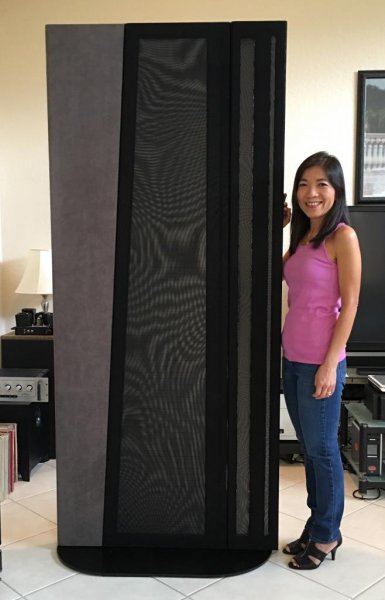Back on topic...

I have not posted much on this forum, but I thought I might share my recent experience with Apogee Full Range speakers in this thread. I bought a refurbished pair directly from Rich Murry of True Sound Works in Minden, NV.
I have posted before about how much I have enjoyed my Apogee Divas. I am an unapologetic “tube guy” and have succeeded in driving the Divas in biamplified mode with two pairs of vintage Audio Research D-250 MkII Servo amps. I have doubled the power supply reserves in each amp to about 1100 joules - about the same as Audio Research’s current flagship, the REF 750. There is no reason why a semi-vintage amplifier such as this model cannot compete toe-to-toe with newer amps. In fact, there is less evidence of cost cutting in the D-250 than in modern ARC products. Bill Johnson went all-out with the 250. The transformers are enormous and there are no cheaper FETs replacing tubes in the front end. The Divas were happy and so was I. And then...
I heard that a fellow had a pair of Apogee Grand speakers for sale. I was curious about these legendary monsters. I discussed them at length with the seller. I knew that I could not live with the built-in Krell amps. As a EE, I figured that I might design tube amp replacements for the upper drivers, at least. I figured I could improve on the circuits having 50+ opamp stages in the crossover and processing sections. In any case I knew it would be an expensive and time-consuming project. I talked to Rich Murry about refurbishment of the Grand’s ribbons. Yes, that can be done. But he told me that, rather than the Grands, the best Apogee model really is the Full Range. He said I would be surprised how much better it can be than even the lovely Divas. I also talked to Bill Thalmann, and to several other Apogee owners, and there seemed to be almost a “sub rosa” consensus that the ultimate model was not the Grand, but the Full Range, Apogee’s very first speaker. The ribbons in the Full Range are actually larger than those in the Grand. Also, there was a sense that the pure aluminum midrange (and tweeter) ribbon, although uncompromising in its low resistance, was more articulate than the Kapton-backed ribbons of the Grand and Diva (as well as numerous other models). The Full Range and Scintillas are alone among the various Apogee models in having pure aluminum midrange ribbons and, not coincidentally, are the two most notoriously challenging models to drive successfully. Subsequent Apogee models used Kapton (or Mylar) to support multiple runs of narrow ribbons which usefully raised the impedance to 4 ohms or more. Even the Grand’s serpentine midrange ribbon was a concession to impedance matching. And, it was said, the Full Ranges were massively built to a higher standard than subsequent models. They are unbelievably heavy. And that’s probably a good thing.
So, long story shorter, all that got me to thinking. And to buying. So I have had the Full Ranges running now for about two weeks. I am just getting to know them, and to start the long journey of optimizing everything around them. I am using the same two pairs of ARC D-250 that worked so well with my Divas. At present, I am using the Full Range’s original passive crossover and interface boxes with their toroidal step-down transformers and passive crossover for the tweeters.
Wow.
Even in this initial, less than optimal configuration, I do not think I have ever heard a better loudspeaker. Yes, they are better than my prior best, the Divas. The Full Ranges seem to be able do it all, and then some. By “then some” I refer to that rare magic that takes one beyond the checklist of satisfied audio requirements. Majestic power and dynamics combine with subtle delicacy. These speakers manage what I think is a rare aspect in sound reproduction: the ability to simultaneously reveal velvet liquidity and sizzling texture, where there should be texture. Voices, strings and piano sound absolutely natural, if the recording is good (you can readily hear differences in microphones and recording quality with these speakers).
So what’s left to improve? Imaging is very good, especially in the front-to-back dimension, but it is still not what I know it can be. I had needed to improve my room treatments even with the Divas. Now I have even greater motivation to do so. The low bass is stunning, but probably can be controlled better.
Right now I am driving the woofer panels using the 4-ohm taps though the bass transformer in the interface box. Rich assured me that directly driving the 1.8 ohm (or so) woofer panels will make a huge improvement. He said that the Pass Labs X600 amps worked well for this. Before going solid-state for the woofers, which is an option, I will next bypass the transformer and drive the woofers directly from the D-250’s 1-ohm taps. My D-250s were among those that were made with undocumented 1-ohm OPT taps, probably with the Scintilla in mind, both being of the eighties. Oh, I should mention that the Full Ranges require the volume control to be set about 5 dB higher than with the Divas. Yes, the Full Ranges really do need the juice.
But for now, I am basking in the sound, and rediscovering old recordings. I will further tweak positioning in the room and other room parameters next, before launching into new electronics. The D-250s seem to mate well with these imposing speakers, at least for now.
Yes, I’d have to say the Full Ranges really are THAT good.
















